Ijraset Journal For Research in Applied Science and Engineering Technology
- Home / Ijraset
- On This Page
- Abstract
- Introduction
- Conclusion
- References
- Copyright
CredBud: The Ultimate Student Platform
Authors: Prof. Vidya Shinde, Pratik Abhang, Darshana Borase, Omkar Darekar, Chaitanya Gunde
DOI Link: https://doi.org/10.22214/ijraset.2025.66721
Certificate: View Certificate
Abstract
In the rapidly evolving educational landscape, effective management of student performance, attendance, and engagement is essential for fostering accountability, motivation, and academic growth. Addressing the limitations of traditional methods, CredBud introduces an innovative digital platform designed to revolutionize academic management. This secure, user-friendly ecosystem empowers both students and faculty to enhance efficiency and collaboration. CredBud’s key features include a credit allocation and grading system to monitor academic progress, a theoretical points mechanism to encourage active participation, and a customizable rewards framework tailored to individual student preferences. The platform incorporates real-time attendance tracking powered by QR code technology, minimizing administrative errors, streamlining processes, and ensuring data accuracy. By allocating points for attendance, CredBud not only incentivizes consistent participation but also fosters a culture of accountability and recognition. Beyond attendance management, CredBud supports assignment verification, grade sheet generation, and token-based incentives to boost academic performance and administrative efficiency. It also consolidates certifications, project records, and other achievements into a centralized repository, simplifying the process of showcasing academic milestones. Designed to meet the dynamic needs of educational institutions, CredBud operates seamlessly across Android, iOS, and web platforms, ensuring broad accessibility and inclusivity. Its iterative development approach emphasizes simplicity, scalability, and robust security, enabling the platform to adapt to emerging educational demands. By integrating cutting-edge technologies and fostering a culture of recognition, motivation, and continuous improvement, CredBud sets a new benchmark for educational engagement and management, redefining academic success for the future.
Introduction
I. INTRODUCTION
In the rapidly evolving domain of higher education, the integration of technology has become a fundamental driver of innovation, process optimization, and academic growth. Traditional academic management systems often fall short in meeting the complex demands of modern educational institutions, resulting in inefficiencies in student engagement, attendance tracking, and recognition of achievements. To address these challenges, CredBud emerges as an innovative digital platform designed to enhance academic experiences through automation, incentivization, and real-time tracking. CredBud adopts a transformative approach to academic management by incorporating real-time attendance tracking via QR code technology, assignment automation, and a rewards-based system to acknowledge and motivate student participation. By assigning points for activities such as class engagement, skill development, and consistent attendance, CredBud cultivates a culture of accountability and active participation, thereby enriching the learning environment. Additional features, including assignment verification, grade sheet generation, and achievement documentation, significantly reduce administrative burdens while improving the overall experience for students and faculty alike. Furthermore, CredBud provides a unified platform for consolidating certifications, project records, and academic accomplishments. This centralized repository not only benefits students by showcasing their comprehensive academic progress but also equips faculty with actionable insights into performance metrics. Its seamless compatibility across Android, iOS, and web interfaces ensures adaptability to diverse educational contexts.
By addressing critical limitations of traditional systems, CredBud exemplifies how technology can redefine academic processes, making them more interactive, inclusive, and rewarding. This paper delves into the design, implementation, and impact of CredBud, offering insights into its transformative role in reshaping the educational landscape and fostering continuous engagement among all stakeholders.
II. STUDIES AND FINDINGS
The development and evaluation of CredBud, a student platform designed to automate processes such as assignments, attendance, credit points, and certificate uploads, were based on structured research methodologies. This transition from manual to automated systems was guided by an extensive review of existing educational technologies, best practices, and the evolving needs of academic institutions.
The platform’s design emphasizes automating term grant projects, optimizing student engagement through real-time tracking of attendance, and streamlining assignment submissions. The integration of credit points and achievement documentation encourages active participation and progress tracking. Simulation tools like Firebase Analytics and the React development environment were used to evaluate CredBud’s performance, focusing on attendance management, credit point tracking, and seamless data synchronization. Usability tests during these simulations offered valuable insights into the platform’s effectiveness, highlighting the importance of continuous refinement and user-centered design for a robust academic tool.
III. METHODOLOGY
- Platform Design and Feature Development: CredBud was designed to automate academic tasks such as assignments, attendance, credit points, and certificate uploads. Features were developed based on a review of existing educational technologies and user needs.
- Data Collection: Data was collected through system logs, user feedback, and performance metrics via Firebase Analytics. Key data points such as engagement, attendance, and assignment submissions were monitored.
- Simulation and Testing: Simulation tools like React were used to model platform behavior in various scenarios, focusing on attendance tracking and data synchronization. Test cases evaluated the system’s scalability, accuracy, and reliability.
- Usability Testing: Usability testing involved students and faculty performing tasks such as attending classes and submitting assignments. Feedback was gathered through surveys to evaluate user satisfaction and ease of use.
A. Agile Methodology
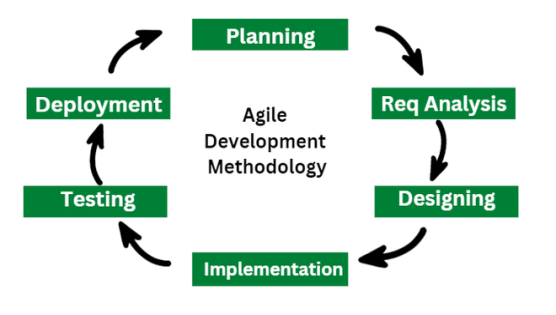
Figure: Agile Methodology
- Requirement Gathering: The team documents stakeholder needs and defines the project's scope, objectives, and resources, including budget and schedule.
- Design: Create high-level system architecture, detailed specifications (data structures, algorithms), and user interface planning.
- Development (Coding): The development team writes the code for the software and conducts unit testing to verify each component's functionality.
- Testing: Conduct various tests to ensure the software's functionality, performance, and user satisfaction, including integration, system, and performance testing.
- Deployment: Release the software to the production environment, ensuring smooth operations and providing training and support for end-users.
- Review (Maintenance): After deployment, address issues, release updates, and apply patches to improve software functionality and performance.
B. Scrum Methodology
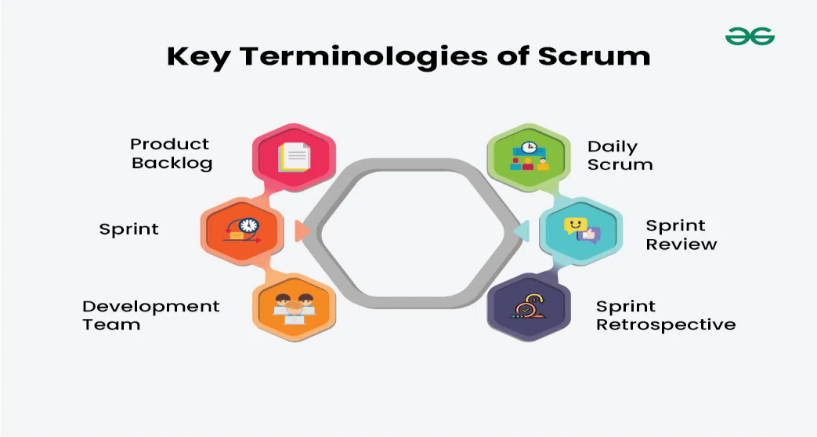
Figure: Scrum Methodology
- Product Backlog: A prioritized list of features, fixes, and improvements that define the product's development roadmap.
- Sprint: A time-boxed iteration, typically lasting 1-4 weeks, in which a product increment is developed and completed.
- Development Team: A group of skilled professionals responsible for the product’s delivery, working collaboratively to achieve sprint goals.
- Daily Scrum: A 15-minute daily meeting where the development team syncs on progress, plans the next 24 hours, and identifies any obstacles.
- Sprint Review: A meeting held at the end of the sprint where the team demonstrates completed work to stakeholders for feedback.
- Sprint Retrospective: A meeting held after each sprint to discuss what went well, identify areas for improvement, and plan actions for the next sprint.
C. Attendance Process
- App Registration: Field personnel install the Attendance Provider app, and recipients install the Attendance Initiator app. Both must register and gain approval through the web portal.
- Attendance Initiation: Before interaction, the recipient uses the Attendance Initiator app to connect to the web portal and generate a unique, computed QR code displayed on their mobile screen.
- QR Code Scanning: The field personnel scans the QR code using their Attendance Provider app. The scanned code is decrypted and sent to the web portal for verification.
- Verification and Timestamping: The web portal cross-verifies the generated code with the returned data, including the unique device ID, Firebase-registered ID, and encrypted QR data. Upon successful validation, a timestamp is recorded in the database, confirming the interaction.
- Authentication and Notification: To ensure authenticity, the system works only on authorized devices. An instant SMS or push notification is sent to an attendance observer for verification, ensuring the designated individual is using the app appropriately.
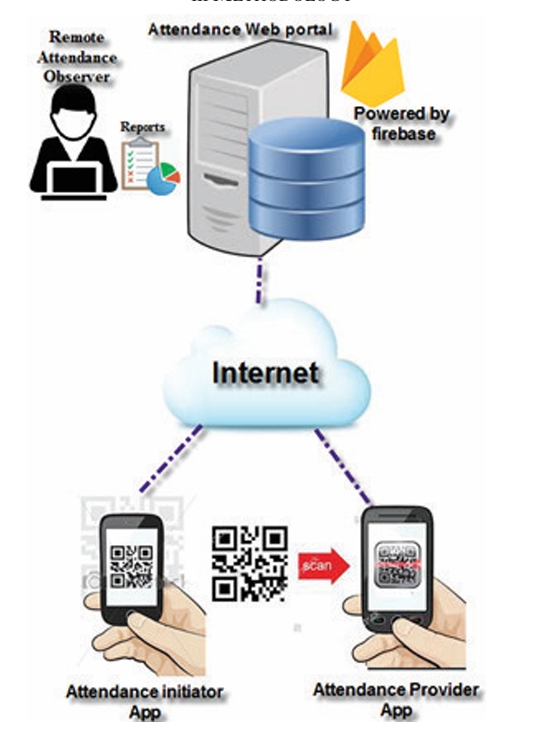
Figure: Architecture frame work of Attendance System
IV. REQUIREMENTS
A. User Interface Requirements
Front-End Design: React, Flutter
Backend: Node.js, Cloud Services, Firebase
Responsive Design: Mobile and desktop compatibility
User Authentication: OAuth, JWT, Firebase Authentication
B. Hardware Requirements
Processors: Minimum of 2 virtual CPUs (vCPUs) per instance
RAM: At least 4GB of memory per instance
Hard Disk Space: Minimum of 100GB
C. Software Requirements
Operating Systems: Windows, Ubuntu, macOS
Development Tools: MS Visual Studio, Node.js, Web Browsers
Version Control: Git (GitHub, GitLab, or Bitbucket)
Database: MySQL, MongoDB, or Firebase for data storage
APIs: RESTful API integration for communication between client and server
V. SYSTEM DESIGN

Figure: Working of system
A. System Block Diagram:
The CredBud system design ensures a seamless, scalable, and user-friendly experience for students, faculty, and moderators. The architecture integrates client-side, server-side, and database components for optimal functionality and performance.
1) Client-Side (User Interfaces)
Mobile App Interfaces: Developed using React Native or Flutter for Android and iOS platforms.
Web Interface: React for the web platform.
Dashboards: Separate dashboards tailored for students, faculty, and moderators.
2) Server
Backend: Built using Node.js and Express.js.
Core Logic: Manages user authentication, notifications, and data processing.
3) Authentication/Admin
Authentication: Role-based access control ensuring that students, faculty, and moderators access appropriate features.
4) User Interaction
User Interaction: API-driven, with Firebase's real-time data synchronization to enable smooth interactions between users and the system.
5) Moderation
Moderator Portal: Secure login for moderators to monitor platform activity, assign points, and validate grant sheets.
6) QR Attendance System
QR Scanner: For marking attendance, integrated with Firebase for real-time updates.
7) News Integration
External API Integration: Fetches and displays industry-related tech/programming news, enriching the user experience.
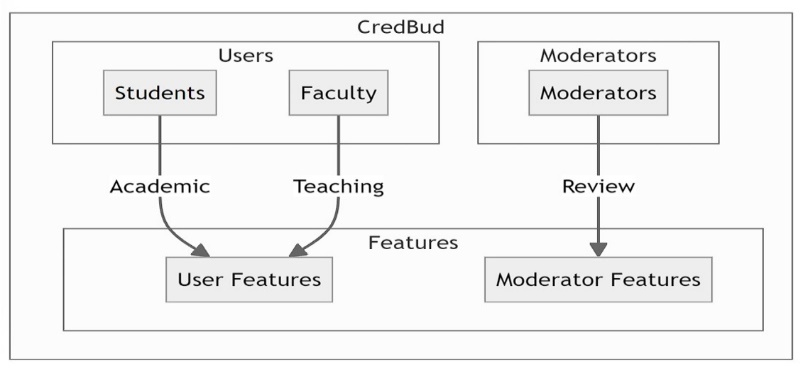
Figure: System Block Diagram
Role-based authentication restricts access to sensitive data, ensuring only authorized users can interact with specific features. APIs and Firebase’s real-time sync provide smooth interactions, while moderators have a secure portal to manage tasks.
VI. DESIGN
The implementation of CredBud revolves around a robust client-server architecture, ensuring seamless user interactions and secure data management.
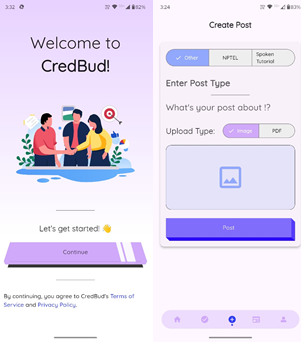
Figure: App Interface
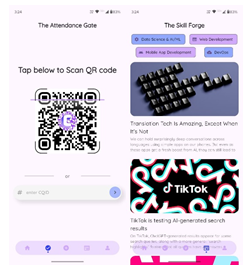
Figure: Attendance & News Section
The application features token-based authentication for secure access, real-time notifications to keep users updated, and data visualization tools like graphs to track attendance trends and performance. A relational database efficiently stores user data, attendance records, and other essential information.

Figure: Profile & Point Store
VII. APPENDIX
A. Problem Statement Feasibility Assessment
The CredBud platform addresses the challenge of efficient attendance tracking and user profile management for a large student base. By leveraging advanced algorithms operating within polynomial time, the system ensures quick data processing, efficient data storage, and retrieval, making attendance tracking scalable and reliable.
B. Mathematical Model
Set Theory:
Input Set: U = {user1,user2,user3,...,usern}
Solution Set: P = {update, query, manage,...}
Conclusion: If all operations op ∈ P can be executed on U in polynomial time, the problem is classified as P.
Time Complexity: Operations like updates and queries are O(n), ensuring swift processing.
Space Complexity: Optimized data structures maintain space requirements at O(n) or less.
C. Conclusion
Through efficient algorithms and data structures, CredBud demonstrates that critical operations like attendance tracking and user management fall within P, ensuring scalability, fast response times, and a resource-conscious platform that effectively serves a dynamic user base.
VIII. IMPROVEMENTS
- Enhanced UI/UX: Redesigned the interface for improved navigation, cleaner layout, and responsive design, with interactive dashboards for better engagement.
- Advanced Analytics: Integrated analytics for better performance tracking, including predictive tools to identify at-risk students.
- Advanced Analytics: Integrated analytics for better performance tracking, including predictive tools to identify at-risk students.
- Improved QR Code Attendance System: Optimized QR scanning for faster recognition, improved accuracy, and added offline functionality for reliable tracking.
- Scalability and Performance Optimization: Enhanced database structures, server performance, and load-balancing to support larger user bases and ensure smooth performance.
- Security Enhancements: Strengthened role-based authentication and data encryption for enhanced user privacy and secure data access.
- Bug Fixes and System Stability: Addressed bugs and minor system glitches to improve overall platform stability and user experience.
- User Feedback Integration: Actively incorporated feedback from students and faculty to improve features and enhance user satisfaction.
Conclusion
CredBud addresses the challenges of student attendance tracking by automating the process with QR code technology, transforming the traditionally manual system into a streamlined, efficient solution. By moving from manual to automated record management, CredBud minimizes errors and inefficiencies while providing real-time tracking and analytics. Beyond attendance, the platform also simplifies academic management processes, reducing administrative workload and improving engagement for both students and educators. With intuitive interfaces and enhanced reporting capabilities, CredBud fosters a more interactive and efficient educational experience. As the platform evolves, future expansions could include further automation of student performance tracking and integration with broader educational management systems, maximizing its potential for improving academic workflows.
References
[1] IEEE Xplore Document.https://ieeexplore.ieee.org/ [2] Smart Education. https://ieeexplore.ieee.org/document/9681472 [3] QR Code System. https://ieeexplore.ieee.org/document/9134225 [4] Case Study of Student Attendance and Record System Design Based on Web and Mobile. https://bit.ly/3YM0xcf [5] Types of UML Diagrams. https://www.lucidchart.com/ [6] Firebase. https://firebase.google.com [7] Flutter Documentation. https://docs.flutter.dev [8] Node.js Documentation. https://nodejs.org/en/docs
Copyright
Copyright © 2025 Prof. Vidya Shinde, Pratik Abhang, Darshana Borase, Omkar Darekar, Chaitanya Gunde. This is an open access article distributed under the Creative Commons Attribution License, which permits unrestricted use, distribution, and reproduction in any medium, provided the original work is properly cited.

Download Paper
Paper Id : IJRASET66721
Publish Date : 2025-01-28
ISSN : 2321-9653
Publisher Name : IJRASET
DOI Link : Click Here
 Submit Paper Online
Submit Paper Online

